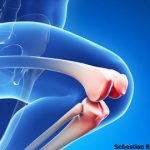The research team identified six findings independently associated with an expert clinician having greater than 70% confidence in a diagnosis of meniscal tear: localized pain, ability to fully bend the knee, pain duration of less than one year, lack of varus alignment, lack of pes planus and absence of joint space narrowing on radiographs.
From these findings, they generated a points-based index, assigning localized pain and the ability to fully bend the knee one point each, lack of varus alignment and lack of pes planus two points each, and pain duration of less than one year and lack of radiographic evidence of joint space narrowing four points each. Higher index scores were associated with an increasing likelihood an expert clinician had 70% or greater confidence of meniscal tear.
The researchers also identified a low-risk group of patients for whom the likelihood of meniscal tear measured just 3%, and a high-risk group for whom the risk measured 54%.
Additionally, they did not find statistically significant nor clinically meaningful associations between mechanical symptoms such as grinding, clicking, locking or the knee giving way, and physician confidence in a meniscal tear.
The findings were simultaneously predictable and surprising, says Dr. Katz, who is also the Clement B. Sledge and Thomas S. Thornhill chair in Orthopedic Surgery, director of the Orthopedic and Arthritis Center for Outcomes Research, and vice chair for Orthopedic Research at Brigham and Women’s.
Not at all surprising was an association between meniscal tear and patients who described their pain as localized to one part of the knee rather than diffuse. Dr. Katz says they were surprised to learn that an absence of findings typically associated with osteoarthritis, such as flat feet, malaligned knee and joint-space narrowing, was positively associated with symptomatic meniscal tear.
The results indicate MRI is not a reliable means for diagnosing meniscal tears, the study authors conclude. “MRI is an awfully good test in that it is sensitive. … The problem is it’s too sensitive,” Dr. Katz says. “Many people have a meniscal tear on MRI, but they are completely asymptomatic.”
For example, Dr. Katz says, “If I sat on Boston Common and I took MRIs of the knees of all the people in their 50s and 60s walking through, I would see tears in 30–40%, and all of them would be asymptomatic with just a few exceptions. It’s normal for people in the community to have things like meniscal tear, disc degeneration, rotator cuff partial tears, [etc., that] don’t cause symptoms.”


